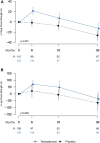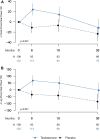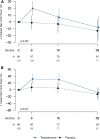Effects of Testosterone Supplementation for 3 Years on Muscle Performance and Physical Function in Older Men
- PMID: 27754805
- PMCID: PMC5413164
- DOI: 10.1210/jc.2016-2771
Effects of Testosterone Supplementation for 3 Years on Muscle Performance and Physical Function in Older Men
Abstract
Context: Findings of studies of testosterone's effects on muscle strength and physical function in older men have been inconsistent; its effects on muscle power and fatigability have not been studied.
Objective: To determine the effects of testosterone administration for 3 years in older men on muscle strength, power, fatigability, and physical function.
Design, setting, and participants: This was a double-blind, placebo-controlled, randomized trial of healthy men ≥60 years old with total testosterone levels of 100 to 400 ng/dL or free testosterone levels <50 pg/mL.
Interventions: Random assignment to 7.5 g of 1% testosterone or placebo gel daily for 3 years.
Outcome measures: Loaded and unloaded stair-climbing power, muscle strength, power, and fatigability in leg press and chest press exercises, and lean mass at baseline, 6, 18, and 36 months.
Results: The groups were similar at baseline. Testosterone administration for 3 years was associated with significantly greater performance in unloaded and loaded stair-climbing power than placebo (mean estimated between-group difference, 10.7 W [95% confidence interval (CI), -4.0 to 25.5], P = 0.026; and 22.4 W [95% CI, 4.6 to 40.3], P = 0.027), respectively. Changes in chest-press strength (estimated mean difference, 16.3 N; 95% CI, 5.5 to 27.1; P < 0.001) and power (mean difference 22.5 W; 95% CI, 7.5 to 37.5; P < 0.001), and leg-press power were significantly greater in men randomized to testosterone than in those randomized to placebo. Lean body mass significantly increased more in the testosterone group.
Conclusion: Compared with placebo, testosterone replacement in older men for 3 years was associated with modest but significantly greater improvements in stair-climbing power, muscle mass, and power. Clinical meaningfulness of these treatment effects and their impact on disability in older adults with functional limitations remains to be studied.
Trial registration: ClinicalTrials.gov NCT00287586.
Copyright © 2017 by the Endocrine Society
Figures




References
-
- Bhasin S, Pencina M, Jasuja GK, Travison TG, Coviello A, Orwoll E, Wang PY, Nielson C, Wu F, Tajar A, Labrie F, Vesper H, Zhang A, Ulloor J, Singh R, D’Agostino R, Vasan RS. Reference ranges for testosterone in men generated using liquid chromatography tandem mass spectrometry in a community-based sample of healthy nonobese young men in the Framingham Heart Study and applied to three geographically distinct cohorts. J Clin Endocrinol Metab. 2011;96(8):2430–2439. - PMC - PubMed
-
- Wu FCW, Tajar A, Beynon JM, Pye SR, Silman AJ, Finn JD, O’Neill TW, Bartfai G, Casanueva FF, Forti G, Giwercman A, Han TS, Kula K, Lean MEJ, Pendleton N, Punab M, Boonen S, Vanderschueren D, Labrie F, Huhtaniemi IT; EMAS Group . Identification of late-onset hypogonadism in middle-aged and elderly men. N Engl J Med. 2010;363(2):123–135. - PubMed
-
- Bhasin S, Woodhouse L, Casaburi R, Singh AB, Mac RP, Lee M, Yarasheski KE, Sinha-Hikim I, Dzekov C, Dzekov J, Magliano L, Storer TW. Older men are as responsive as young men to the anabolic effects of graded doses of testosterone on the skeletal muscle. J Clin Endocrinol Metab. 2005;90(2):678–688. - PubMed
-
- Krasnoff JB, Basaria S, Pencina MJ, Jasuja GK, Vasan RS, Ulloor J, Zhang A, Coviello A, Kelly-Hayes M, D’Agostino RB, Wolf PA, Bhasin S, Murabito JM. Free testosterone levels are associated with mobility limitation and physical performance in community-dwelling men: the Framingham Offspring Study. J Clin Endocrinol Metab. 2010;95(6):2790–2799. - PMC - PubMed
-
- Roy TA, Blackman MR, Harman SM, Tobin JD, Schrager M, Metter EJ. Interrelationships of serum testosterone and free testosterone index with FFM and strength in aging men. Am J Physiol Endocrinol Metab. 2002;283(2):E284–E294. - PubMed
Publication types
MeSH terms
Substances
Associated data
Grants and funding
LinkOut - more resources
Full Text Sources
Other Literature Sources
Medical

